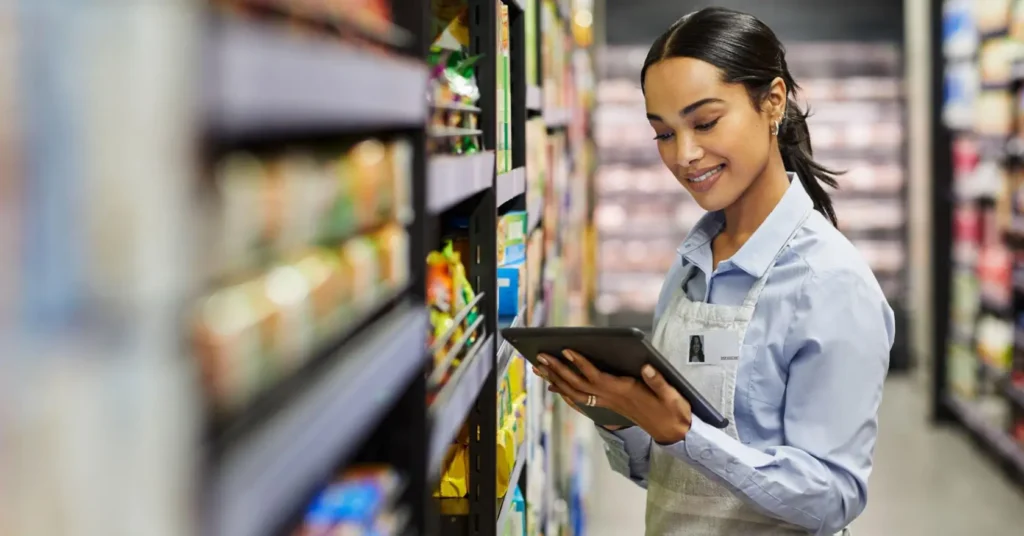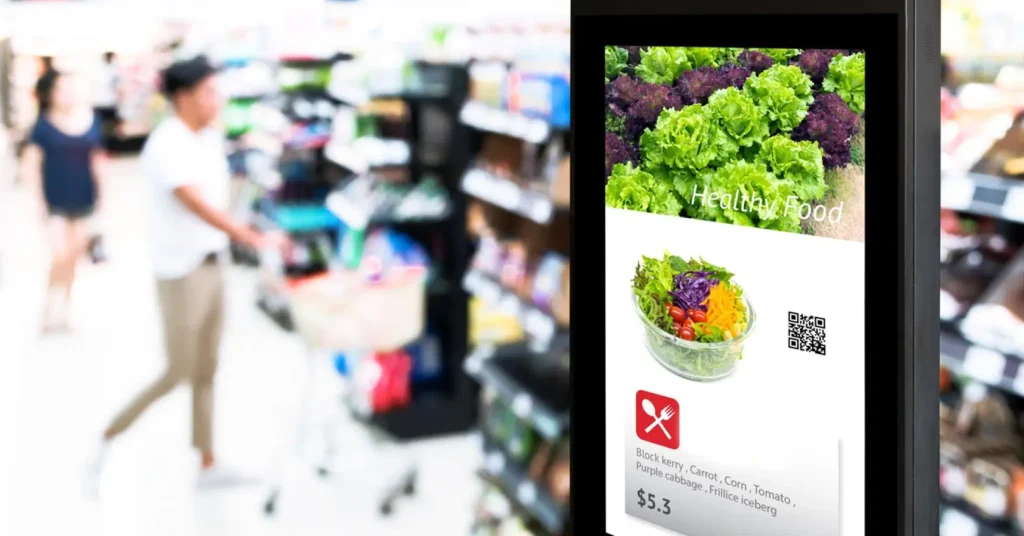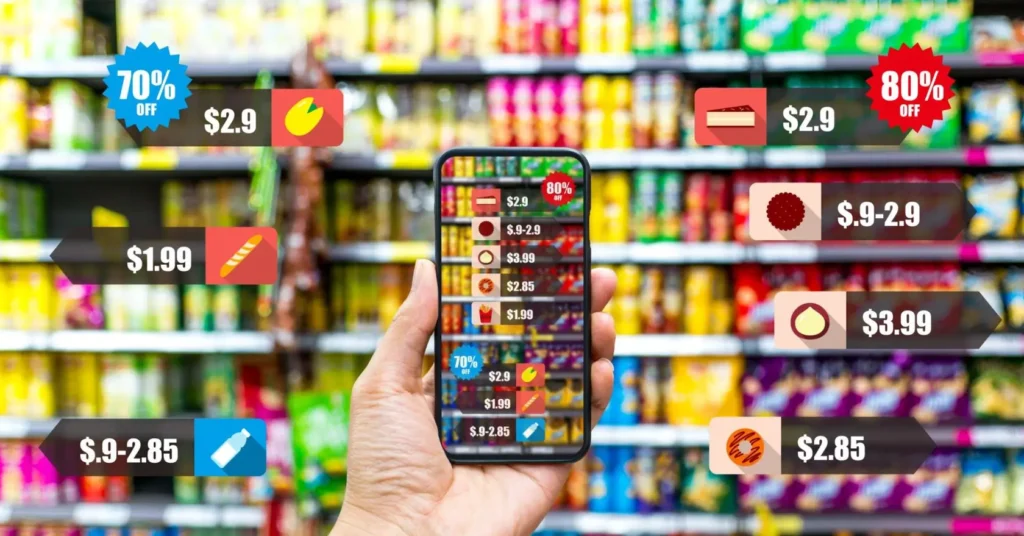In today’s fast-paced world Digital marketing has become crucial to every successful business strategy. It is becoming increasingly important for grocery stores to use digital marketing to expand their reach, engage customers, and drive sales.
Research found that global digital advertising income would exceed one trillion dollars by 2027 and it is forecasted that Digital grocery will be a $243 billion market in the US by 2025.
Grocery stores must adapt and employ multiple digital marketing channels to remain competitive, given the rise of online shopping and the convenience of mobile devices.
Moreover, a carefully designed digital marketing strategy may help grocery stores enhance brand exposure, customer loyalty, and sales. Additionally, grocery stores can benefit from digital marketing in various ways, including social media advertising, email marketing, and search engine optimization.
However, knowing where to begin can be challenging with so many different channels and tactics. That is why it is critical to comprehend the fundamentals of digital marketing and how they apply to the grocery business.
If you are a grocery store owner looking to take your business to the next level, keep reading to learn more about how digital marketing can help you succeed in today’s digital age.

What Is Digital Marketing For Grocery Stores?
Digital marketing for grocery stores entails promoting grocery items and services via different online channels to reach new customers and increase sales.
Consumers are increasingly turning to digital channels to explore, compare, and purchase products in today’s world, and grocery stores must adapt to this shift in customer behaviour to remain competitive.
Marketing Strategy For Online Grocery Store
Here are some effective digital marketing strategies for grocery stores:
- Create A Google My Business Page For Each Of Your Locations
Google My Business is a free and simple service that helps businesses to manage their web presence across Google products such as Search and Maps.
By creating a Google My Business page for each grocery store location, you can ensure that your store information, such as store hours, phone number, and address, is current and up to date.
Customers will be able to find your store more easily, and your search engine rating will rise. In addition, customers can also post evaluations on your Google My Business page, which can help you attract new customers while building trust with existing ones.
- Create A Mobile-Friendly Website
A grocery store’s website should be mobile-friendly because many customers use their mobile devices to search for products online. The website should be simple, provide product and pricing information, and allow customers to buy things online.
- Search Engine Optimisation (SEO)
Grocery stores should optimize their websites for search engines so that when a customer searches for a grocery store online, their website appears at the top of search engine results.
This can be accomplished by employing relevant keywords, producing high-quality content, and establishing high-quality backlinks.
- Leverage Social Media
Grocery stores can promote their products and services through social media platforms such as Facebook, Twitter, and Instagram. They can use sponsored advertisements, compelling content, and contests to attract customers.
- Email Marketing
Email marketing can be used by grocery stores to promote their products and services, offer discounts, and educate customers about new products. This can help to boost customers loyalty and sales.
- Local SEO
To attract customers from their immediate neighbourhood, grocery retailers should optimize their websites for local search results.
This can be accomplished by including the store’s address and phone number on the website, developing local content, and listing in local directories.
- Online Advertising
Grocery companies can target potential customers with relevant ads using online advertising platforms such as Google Ads and Facebook Ads.
They can establish a budget and target specific demographics based on age, gender, geography, interests, and other factors.
- Influencer Marketing
Grocery stores can work with influencers with strong social media following to promote their products. This can assist in reaching a larger audience and increasing brand exposure.
- Provide Easy Access With QR Code
QR codes are a simple and effective method of providing quick access to information. Customers can rapidly obtain information about products, promotions, or discounts by scanning QR codes strategically placed throughout the store.
This can improve the shopping experience and encourage customers to buy more.
- Conduct SMS Promotional Campaigns
SMS campaigns can be a powerful tool for promoting your grocery store’s products and services to customers. Text messaging lets you provide special deals, discounts, or promotions to your customers. This can aid in increasing consumer loyalty and sales.
To sum up, digital marketing for grocery stores is crucial in today’s digital age. Grocery stores should use different digital marketing strategies to reach potential customers, build brand awareness, and increase sales.
By implementing these strategies, grocery stores can stay ahead of the competition and grow their business.

Grocery Store Marketing Plan
Sure, here’s an outline for a grocery store marketing plan:
- Define your target audience: Before developing a marketing strategy, you must determine your target audience. Age, gender, financial level, and lifestyle are examples of demographics.
- Perform a SWOT analysis: Examine the strengths, weaknesses, opportunities, and dangers of your grocery shop. This will assist you in identifying areas where your marketing efforts can be improved and opportunities identified.
- Create a brand identity: Create a consistent and recognizable brand identity that reflects the values and mission of your grocery shop. Creating a logo, colour scheme, and tagline is part of this process.
- Make a website: Create a website highlighting your grocery store’s products, services, and specials. Make sure the website is mobile-friendly and simple to use.
- Use social media sites: Use social media sites to communicate with your target audience and advertise your grocery store’s offerings, such as Facebook, Instagram, and Twitter.
- Offer promotions: To encourage repeat business and attract new customers, offer discounts, coupons, and loyalty programmes.
- Organise events: Create a sense of community and generate excitement by hosting in-store activities such as cooking courses, wine tastings, and product demos.
- Collaboration with local businesses: Collaborate with local businesses like restaurants and farmers’ markets to cross-promote each other’s offerings and reach a larger audience.
- Results should be measured as follows: Analyse website traffic, social media engagement, and sales data to determine the success of your marketing activities. Use this data to fine-tune your marketing approach and future campaigns.
- Answer the following questions to yourself: What do you sell? What distinguishes you? Who is your target market? Where do you work?
Following these steps, you can create a comprehensive grocery store marketing plan that effectively reaches your target audience and drives business growth.

Grocery Store Content Ideas
Following are some of the content ideas for grocery store:
- Tips for Healthy Eating
Share tips for healthy eating and healthier food choices.
- Seasonal Produce
Highlight the fruits and vegetables that are currently in season, along with cooking suggestions.
- Cooking Videos
Produce short cooking videos that showcase simple and delicious dishes that customers can make using products from your store.
- Meal Preparation
Provide meal preparation tips and ideas for busy families and people trying to save time and money while eating properly.
- Product Reviews
Highlight the characteristics and benefits of popular or new products in your business to assist buyers in making informed purchasing decisions.
- Promote Promotions
Weekly or monthly promotions should be promoted in your store, with discounts and other customer incentives.
- Local Products
Display locally sourced products in your store, emphasizing the distinct flavours and benefits of purchasing locally.
- Social Media Contests
Hold social media contests to engage your customers and encourage them to post their favourite recipes or meal ideas that incorporate your products.
- Workshops and Demos
Cooking demos, nutrition workshops, and exercise classes are examples of health and wellness events that can be held in your store.
- Share Information
Share information about your store’s sustainability initiatives, such as reducing food waste, using environmentally friendly packaging, or supporting local farmers and producers.

Advertisement For Grocery Store
According to statista, statistics and facts about the Canadian online grocery market
Supermarkets and grocery stores’ retail sales in Canada have consistently increased in recent years, hitting nine billion Canadian dollars in June 2022.
Advertising is crucial for a grocery business because it attracts new consumers, retains existing customers, and eventually increases sales.
A grocery business can communicate its unique value proposition to potential customers by supplying high-quality products at competitive costs through advertising.
Advertising can also assist a grocery shop in differentiating itself from competitors by emphasizing its distinctive goods, such as locally produced vegetables or specialty items.
This can aid in developing a loyal consumer base and increase customer loyalty.
Furthermore, advertising can help to raise awareness of new products or promotions, resulting in increased foot traffic and, ultimately, increased sales.
Moreover, a grocery business can keep customers informed and interested by sharing these deals through advertising platforms such as social media, email newsletters, or print ads.
In a nutshell, advertising is an important part of a successful grocery store strategy, as it helps to attract new customers, maintain existing ones, and increase sales.

Best Grocery Store Advertising Campaigns
Overall, the most effective grocery store advertising campaigns are those that speak to the values and priorities of their target customers.
Grocery stores can build trust, loyalty, and strong brand identity by understanding what matters most to their customers and tailoring their messaging accordingly.
There have been many successful grocery store advertising campaigns over the years, but here are a few examples that stand out:
- Walmart’s “Everyday Low Prices”
Walmart’s “Everyday Low Prices” marketing has effectively expressed its value proposition to customers.
Walmart has built a devoted consumer base that trusts them to provide good value by emphasizing that they offer low pricing every day rather than just during discounts or promotions.
- Safeway “Just For U”
Safeway’s “Just For U” promotion offers personalized coupons and discounts to attract and keep customers.
Safeway has increased customer loyalty and encouraged repeat purchases by analyzing customer data and personalizing advertisements to individual shoppers.
- Lidl’s “Eat Well for Less” Campaign.
Lidl’s “Eat Well for Less” promotion aims to promote healthy eating on a budget. Lidl has been able to appeal to health-conscious consumers who are also price-conscious by promoting economical and healthy meal options.
- Kroger’s “Ingredients for Life”
Kroger’s “Ingredients for Life” campaign emphasizes the company’s dedication to quality products and sustainable sourcing.
Kroger has been able to differentiate itself from other supermarket stores and appeals to environmentally aware shoppers by emphasizing their focus on fresh, healthy, and locally sourced products.
Takeaway
In conclusion, digital marketing is game-changing for grocery stores. The rise of e-commerce and internet buying has dramatically impacted how people shop for groceries.
Grocery stores that have adopted digital marketing methods have been able to contact their target demographic and increase sales.
Grocery stores can better engage with customers and provide personalized experiences by utilizing social media marketing, email marketing, and search engine optimization (SEO).
These tactics assist grocery retailers in increasing consumer involvement and loyalty while increasing their bottom line.
If you want to take your grocery store’s digital marketing strategy to the next level, ByteTeck Consulting can help. Our team of experts offers game-changing strategies and solutions for various industries, including grocery stores.
Contact us today to learn more about how we can help your business thrive in the digital world.
How do grocery stores advertise?
What is an example sentence for a grocery store?
How do I advertise my online grocery store?
What is supermarket special advertising?
How much does it cost to advertise in a supermarket?
For pricing information, it is preferable to contact the supermarket directly.
How to do digital marketing for grocery stores?
How do I promote my small grocery store?
How are digital technologies transforming retail grocery markets?
How do I advertise my supermarket on social media?




